British Army: Difference between revisions
No edit summary |
No edit summary |
||
| (9 intermediate revisions by the same user not shown) | |||
| Line 2: | Line 2: | ||
[[File:Havercakes.jpg|thumb|300px|right|Recruiting for the 33rd Foot]] | [[File:Havercakes.jpg|thumb|300px|right|Recruiting for the 33rd Foot]] | ||
The Army did not have the same requirements as the [[The Royal Navy|Royal Navy]] – it was not a professional career in the same way. A young man joining the Army would buy a commission as Ensign (in a foot regiment; the cavalry equivalent was cornet) at anything from the age of fourteen upwards. This placed him automatically at a higher rank than a Navy midshipman, who did not hold a commission. | The Army did not have the same requirements as the [[The Royal Navy|Royal Navy]] – it was not a professional career in the same way. A young man joining the Army would buy a commission as Ensign (in a foot regiment; the cavalry equivalent was cornet) at anything from the age of fourteen upwards. This placed him automatically at a higher rank than a Navy midshipman, who did not hold a commission. | ||
<br/><br/> | |||
[[File:Officers.jpg|thumb|300px|right|A Lieutenant and an Ensign in Spain]] | |||
It is a misconception, though a common one, that officers had to have a university degree, or to be over a certain age. This has crept in thanks to modern requirements, but in 1811 it was possible for a boy of twelve or thirteen to hold a commission as an Ensign, if his father could pay for it. There were also certain regiments with boy drummers who would go on to serve in the ranks as private soldiers (the drummer boy is a staple of fiction set during this era, as is the boy officer). Overall, this meant that the average age of an officer in any rank is far lower than the age of an officer of the same (or equivalent) rank in the modern British Army. | |||
<br/><br/> | |||
Army officers learned 'on the job': There were no formal qualifications for holding a commission. An officer had to know how to read and write, and in the late 18th century and into the early years of the Regency, the majority of officers were from the upper classes, the gentry and aristocracy. By the end of the Peninsular War in 1814, this was no longer the case. Approximately 20% of officers were promoted from the ranks and more had gained their commissions by merit rather than purchase – several young men, unable to afford the purchase price, had been able to join as 'gentlemen volunteers', messing with the officers but doing the duties of a private soldier until a vacancy occurred that they could fill. | Army officers learned 'on the job': There were no formal qualifications for holding a commission. An officer had to know how to read and write, and in the late 18th century and into the early years of the Regency, the majority of officers were from the upper classes, the gentry and aristocracy. By the end of the Peninsular War in 1814, this was no longer the case. Approximately 20% of officers were promoted from the ranks and more had gained their commissions by merit rather than purchase – several young men, unable to afford the purchase price, had been able to join as 'gentlemen volunteers', messing with the officers but doing the duties of a private soldier until a vacancy occurred that they could fill. | ||
<br/><br/> | |||
This was one of the few ways that a man with ambition could make the leap to becoming a gentleman, despite the risks. | This was one of the few ways that a man with ambition could make the leap to becoming a gentleman, despite the risks. | ||
| Line 9: | Line 13: | ||
==Army Organisation== | ==Army Organisation== | ||
[[File:Cavalry charge.jpg|thumb|300px|right|Charge by the Heavy Cavalry of the Scots Greys]]There were three main groupings within the British Army: Horse, Foot and Artillery (or, more properly, Cavalry, Infantry and Artillery) | [[File:Cavalry charge.jpg|thumb|300px|right|Charge by the Heavy Cavalry of the Scots Greys]]There were three main groupings within the British Army: Horse, Foot and Artillery (or, more properly, Cavalry, Infantry and Artillery) | ||
===The Cavalry=== | ===The Cavalry=== | ||
[[File:Vidette.jpg|thumb|300px|right|A vidette of Light Dragoons]]There were three main types of cavalry: Household, Heavy and Light. | [[File:Vidette.jpg|thumb|300px|right|A vidette of Light Dragoons]]There were three main types of cavalry: Household, Heavy and Light. | ||
The Household Cavalry were heavy cavalry. Their main task being that of guarding the Royal Household (hence the name) meant that they did not go on active service abroad until 1812. There were (and still are) two main Household Cavalry regiments, the Life Guards. The third Household Cavalry regiment, the Blues, was not confirmed as such until 1820. | The Household Cavalry were heavy cavalry. Their main task being that of guarding the Royal Household (hence the name) meant that they did not go on active service abroad until 1812. There were (and still are) two main Household Cavalry regiments, the Life Guards. The third Household Cavalry regiment, the Blues, was not confirmed as such until 1820. | ||
The Heavy Cavalry comprised the Heavy Dragoons, who were the shock troops of the day. | The Heavy Cavalry comprised the Heavy Dragoons, who were the shock troops of the day. | ||
A cavalry regiment was made up of a number of squadrons, usually about six, each made up of two troops, and numbered about | [[File:33rd_Foot_at_Waterloo.jpg|thumb|300px|right|The 33rd with their Colours at Waterloo]]The Light Cavalry (either Light Dragoons or Hussars) were the scouting experts. | ||
A cavalry regiment was made up of a number of squadrons, usually about six, each made up of two troops, and numbered about 900 men when at full strength. A squadron was commanded by a Captain, and each troop was under the command of a Lieutenant, with a Cornet to assist him. | |||
(Note: There have been far fewer representations on-screen of the cavalry when compared with the infantry, and fewer still of Light Cavalry) | (Note: There have been far fewer representations on-screen of the cavalry when compared with the infantry, and fewer still of Light Cavalry) | ||
| Line 25: | Line 35: | ||
===The Infantry=== | ===The Infantry=== | ||
The British army of the time was structured around the regiment. Each Regiment had a number and in the Napoleonic Wars, the regiments were beginning to be associated with particular areas, such as the 33rd's association with the West Riding of Yorkshire. This area would be where they drew (or tried to draw) the majority of their recruits, and the regimental depot (headquarters and training camp) would be located. | The British army of the time was structured around the regiment. Each Regiment had a number and in the Napoleonic Wars, the regiments were beginning to be associated with particular areas, such as the 33rd's association with the West Riding of Yorkshire. This area would be where they drew (or tried to draw) the majority of their recruits, and the regimental depot (headquarters and training camp) would be located. | ||
Most regiments, but by no means all, had two battalions. The First Battalion, the more senior one, would be the one on campaign while the Second Battalion remained at home, acting as the recruiting and training centre for the Regiment. | Most regiments, but by no means all, had two battalions. The First Battalion, the more senior one, would be the one on campaign while the Second Battalion remained at home, acting as the recruiting and training centre for the Regiment. | ||
[[File:Soldier_of_the_27th.jpg|thumb|300px|right|Detail of a soldier of the 27th Foot, showing facing colour and lace]] Within each battalion were ten Companies, each (when at full strength) with 100 men, including NCOs (non-commissioned officers). A Company was under the command of a Captain, and he had a Lieutenant and an Ensign under him. A battalion would have eight 'centre' or 'battalion' companies and two 'flank' companies. When in line, the Grenadier Company, made up of the tallest, strongest soldiers, stood on the right, and the Light Company, made up of the quickest and nimblest men, was on the left, with the Colours in the middle of the line. | [[File:Soldier_of_the_27th.jpg|thumb|300px|right|Detail of a soldier of the 27th Foot, showing facing colour and lace]] Within each battalion were ten Companies, each (when at full strength) with 100 men, including NCOs (non-commissioned officers). A Company was under the command of a Captain, and he had a Lieutenant and an Ensign under him. A battalion would have eight 'centre' or 'battalion' companies and two 'flank' companies. When in line, the Grenadier Company, made up of the tallest, strongest soldiers, stood on the right, and the Light Company, made up of the quickest and nimblest men, was on the left, with the Colours in the middle of the line. | ||
The Colours were two big flags, made of silk, 6 feet by 6 feet 6 inches, on a nine-feet pole. One, the Regimental Colour, was the Regimental 'facing' colour and the other, the King's Colour was a Union flag. These two flags marked the presence of the Regiment. It was a great disgrace to lose the Colours and at the Battle of Albuera, the two Ensigns of the 3rd Foot ended up tearing the silk from the poles and wrapping it around them to protect them. | |||
The Colours were two big flags, made of silk, 6 feet by 6 feet 6 inches, on a nine-feet pole. One, the Regimental Colour, was the Regimental 'facing' colour and the other, the King's Colour was a Union flag. These two flags marked the presence of the Regiment. It was a great disgrace to lose the Colours and at the Battle of Albuera (on the 16th May 1811), the two Ensigns of the 3rd Foot ended up tearing the silk from the poles and wrapping it around them to protect them. | |||
[[File:Riflemen.jpg|thumb|300px|right|Riflemen of the 5th Battalion 60th Rifles]] By the end of the Peninsular War, very few Regiments were at anything like full strength; there were regiments who stood in the line of battle with as few as 500 men. The Guards Regiments were almost the only exceptions to this, as they were the elite. | [[File:Riflemen.jpg|thumb|300px|right|Riflemen of the 5th Battalion 60th Rifles]] By the end of the Peninsular War, very few Regiments were at anything like full strength; there were regiments who stood in the line of battle with as few as 500 men. The Guards Regiments were almost the only exceptions to this, as they were the elite. | ||
The Rifle Regiments did not carry Colours. They were also very different in their style of dress, their uniform being green and the officers' uniforms being based on those of the Light Dragoons. | The Rifle Regiments did not carry Colours. They were also very different in their style of dress, their uniform being green and the officers' uniforms being based on those of the Light Dragoons. | ||
Each regiment was dressed similarly, with the most noticeable differences being in the colour of the collars, cuffs and shoulder straps (collectively known as 'facings') of the men's jackets. They | |||
Each regiment was dressed similarly, with the most noticeable differences being in the colour of the collars, cuffs and shoulder straps (collectively known as 'facings') of the men's jackets. They would be further differentiated by the pattern of the worsted tape, called lace, that they wore. Most infantry regiments (up to about a third of the Army) wore facings in various shades of yellow, and several regiments had green facings. There were some colours that were only worn by one regiment - such as the orange worn by the 35th Sussex Regiment, or the purple of the 56th West Essex. | |||
===Guards and Line Regiments=== | |||
On the face of it, the Guards and Line look very similar, except that the Guards - the elite - generally took the tallest, smartest men they could. The Guards regiments were the 1st Foot Guards - after Waterloo also titled the Grenadier Guards; the 2nd Foot Guards or Coldstream Guards and the 3rd Foot Guard or Scots Guards. (The Welsh Guards were formed decades later). When at home in England, it was the Guards regiments who were tasked (as they are today) with guarding the royal residences, primarily Windsor Castle). Note: Although even in the Napoleonic era, the bearskin would be worn when in full dress (such as when on guard at Windsor Castle), when on campaign the soldiers wore the same black stovepipe shako worn by all other infantry soldiers. | |||
The regular line regiments were numbered from the 1st Foot, or Royal Scots, all the way up to the 104th, raised for the War of 1812 between Britain and America. By the Napoleonic era, most regiments had a county designation or other title as well as a number - the 2nd Foot were the Queen's Regiment, the 3rd was the East Kent Regiment, nicknamed the Buffs or Old Buffs because of the buff - cream or off-white - colour of their facings. When referring to a Foot Guards regiment by its number, the designation 'Foot Guards' must always be used because the 1st Foot, 2nd Foot and 3rd Foot are regular line regiments and not Guards regiments - they are the Royal Scots, Queen's and East Kent regiments respectively. | |||
[[File:Royal_Artillery.jpg|thumb|300px|right|Two gunners of the Royal Foot Artillery]]During the eighteenth century, once a war was over and peace was declared, regiments were disbanded. Usually the newest formed regiments (those with the highest regimental number) would be disbanded first. This was a direct response to the fear that a permanent standing army could rise and help its leaders take power - which was precisely what had happened in the 1640s with Cromwell and his New Model Army. | |||
===The Artillery=== | ===The Artillery=== | ||
The Artillery came under the control of the Board of Ordnance, and its officers were drawn mainly from the middle class. They attended the academy at Woolwich to learn the science of their trade. Promotion was by seniority alone. | |||
==Rank Structure== | ==Rank Structure== | ||
The rank structure of the Army was simpler than that of the Navy. Broadly speaking, there were two classes: Officers and men. The Other Ranks were: | The rank structure of the Army was simpler than that of the Navy. Broadly speaking, there were two classes: Officers and men (also referred to as 'rank and file' or, in modern parlance, 'Other Ranks' which covers the non-commissioned officers promoted from the ranks). The Other Ranks were: | ||
The ''ranks'' of Colour Sergeant and Sergeant Major did not come into | Private (or equivalent, such as Guardsman or Fusilier) - Pte, in British Army shorthand | ||
<br/>Lance Corporal - L/Cpl | |||
<br/>Corporal - Cpl | |||
<br/>Sergeant - Sgt | |||
The ''ranks'' of Colour Sergeant and Sergeant Major did not come into existence before 1813, although the ''positions'' existed. A Colour Sergeant, before 1813, was merely a sergeant who was tasked with protecting the Colours. The Sergeant Major was what is now known as the Regimental Sergeant Major, and was the senior NCO of a regiment. | |||
Officers' ranks were: | Officers' ranks were: | ||
Ensign (or Cornet, in the cavalry. The Rifles' equivalent was 2nd Lieutenant.) | |||
<br/>Lieutenant | Ensign (or Cornet, in the cavalry. The Rifles' equivalent was 2nd Lieutenant.) - Ens | ||
<br/>Captain (usually in charge of a Company of 100 men) | <br/>Lieutenant - Lt | ||
<br/>Major (there were two Majors with a battalion) | <br/>Captain (usually in charge of a Company of 100 men) - Capt | ||
<br/>Lieutenant Colonel (the officer in charge of a battalion of 1000 men, at full strength) | <br/>Major (there were two Majors with a battalion) - Maj | ||
<br/>Colonel | <br/>Lieutenant Colonel (the executive officer in charge of a battalion of 1000 men, at full strength) - Lt-Col | ||
<br/>Brigadier | <br/>Colonel (the officer in command of a full regiment) - Col | ||
<br/>Major General | <br/>Brigadier - Brig | ||
<br/>Lieutenant General | <br/>Major General - Maj Gen | ||
<br/>General | <br/>Lieutenant General - Lt Gen | ||
<br/>General Gen | |||
Colonel was the highest rank available by purchase; anything higher was by seniority alone - when Wellesley was sent out to take charge of the Army in Portugal in 1808, a large number of officers senior to him were promoted in order that he could receive a promotion from Major General to Lieutenant General. | |||
==Purchasing a Commission== | ==Purchasing a Commission== | ||
[[File: | [[File:Officers1.jpg|right|300px|Officers of the Light Cavalry (left) and infantry]] | ||
On joining the Army as an officer, a young man would purchase his initial commission (as Ensign) in a regiment. This was also referred to as 'buying ones Colours', the Colours being the two six feet square silk flags that marked a Regiment's position in battle. These flags were generally carried by the two junior ensigns of the Regiment, and protected by a group of senior NCOs, Colour Sergeants, who carried halberds or half-pikes. | |||
The cost of an Ensigncy varied greatly depending on how fashionable the regiment he was joining was - a commission in the Guards cost a great deal more than the same rank in a line regiment such as the 50th Foot. Once he had served for a year or so, the Ensign could then purchase a promotion to Lieutenant by paying the difference between the value of the Ensigncy and the Lieutenancy, but he had to have served a minimum of a year as Ensign. | The cost of an Ensigncy varied greatly depending on how fashionable the regiment he was joining was - a commission in the Guards cost a great deal more than the same rank in a line regiment such as the 50th Foot. Once he had served for a year or so, the Ensign could then purchase a promotion to Lieutenant by paying the difference between the value of the Ensigncy and the Lieutenancy, but he had to have served a minimum of a year as Ensign. | ||
An officer could purchase a Captaincy in the same way, after a minimum of three years as Lieutenant. After a further two years, he could purchase his way up to Major, and thence to Lieutenant Colonel, then Colonel. Any promotions after that depended wholly upon his position in the Army List – the senior Colonels would be promoted to General as vacancies became available. Although the rank of Field Marshal existed, there was not a Field Marshall in the British Army at this time until 1814, when the Prince Regent promoted Wellington to that rank after the Battle of Vittoria. | An officer could purchase a Captaincy in the same way, after a minimum of three years as Lieutenant. After a further two years, he could purchase his way up to Major, and thence to Lieutenant Colonel, then Colonel. Any promotions after that depended wholly upon his position in the Army List – the senior Colonels would be promoted to General as vacancies became available. Although the rank of Field Marshal existed, there was not a Field Marshall in the British Army at this time until 1814, when the Prince Regent promoted Wellington to that rank after the Battle of Vittoria. | ||
Officers had to provide their own uniform (usually of scarlet superfine cloth - or blue superfine for light Cavalry officers) as well as their own camp equipment, tent etc. It was unusual for infantry officers below the rank of Captain to ride, but captains and above were more often mounted than not, especially on the march - and they had to provide their own horse and tack too. Cavalry officers also provided their own horses (usually of higher qualities than the men's troopers) and tack. It was very common for subalterns to club together to share the costs of a tent and pack-mule, whereas officers of the rank of Captain and above more often bought their own. | Officers had to provide their own uniform (usually of scarlet superfine cloth - or blue superfine for light Cavalry officers) as well as their own camp equipment, tent etc. It was unusual for infantry officers below the rank of Captain to ride, but captains and above were more often mounted than not, especially on the march - and they had to provide their own horse and tack too. Cavalry officers also provided their own horses (usually of higher qualities than the men's troopers) and tack. It was very common for subalterns to club together to share the costs of a tent and pack-mule, whereas officers of the rank of Captain and above more often bought their own. | ||
It was common to purchase a promotion into a different regiment where there was a vacancy, rather than waiting for a vacancy to occur in the regiment an officer was currently serving in. Such transactions would be handled by regimental agents, who knew and could deal with all the intricacies involved. It was also a frequent occurrence for one officer to arrange to exchange with another (usually poorer) officer of the same rank if his regiment was going to be posted abroad – for example, to the West Indies, which was an extremely unhealthy posting in the days before vaccinations against diseases such as yellow fever, which was very prevalent there, and usually lethal. | It was common to purchase a promotion into a different regiment where there was a vacancy, rather than waiting for a vacancy to occur in the regiment an officer was currently serving in. Such transactions would be handled by regimental agents, who knew and could deal with all the intricacies involved. It was also a frequent occurrence for one officer to arrange to exchange with another (usually poorer) officer of the same rank if his regiment was going to be posted abroad – for example, to the West Indies, which was an extremely unhealthy posting in the days before vaccinations against diseases such as yellow fever, which was very prevalent there, and usually lethal. | ||
An officer did not have to purchase every promotion; after a major battle there were usually vacancies that meant surviving officers were promoted. An officer could also be gazetted to a more senior rank. This was basically a field promotion, but had to be ratified by Horse Guards (the Army equivalent of the Admiralty). It was also common for a man to hold a rank within the army as a whole that he did not hold within his regiment. This meant that a Captain could act with the authority of a Major (and would actually be addressed as Major) while on detached service away from his regiment, but would revert to Captain when back with his regiment. | An officer did not have to purchase every promotion; after a major battle there were usually vacancies that meant surviving officers were promoted. An officer could also be gazetted to a more senior rank. This was basically a field promotion, but had to be ratified by Horse Guards (the Army equivalent of the Admiralty). It was also common for a man to hold a rank within the army as a whole that he did not hold within his regiment. This meant that a Captain could act with the authority of a Major (and would actually be addressed as Major) while on detached service away from his regiment, but would revert to Captain when back with his regiment. | ||
==Retiring== | ==Retiring== | ||
When an officer of the rank of Colonel or below wished to retire, he could 'sell out' which meant selling his commission for its full price, creating a vacancy so that more junior officers could move up the ranks. He might choose instead to transfer to the half-pay list. This was a list of retired or invalided officers who did not wish, or could not, serve in the field. They received half-pay, which was a sort of pension, paid every quarter or so. [[Gerald Stapleton]] is one such officer. The actual income was not actually half the pay they would receive as serving officers. | When an officer of the rank of Colonel or below wished to retire, he could 'sell out' which meant selling his commission for its full price, creating a vacancy so that more junior officers could move up the ranks. He might choose instead to transfer to the half-pay list. This was a list of retired or invalided officers who did not wish, or could not, serve in the field. They received half-pay, which was a sort of pension, paid every quarter or so. [[Gerald Stapleton]] is one such officer. The actual income was not actually half the pay they would receive as serving officers. | ||
A Naval Lieutenant was the equivalent of an Army Captain. | A Naval Lieutenant was the equivalent of an Army Captain. | ||
A Naval Captain was the equivalent of an Army Lieutenant Colonel | A Naval Captain was the equivalent of an Army Lieutenant Colonel | ||
==Rates of Pay== | ==Rates of Pay== | ||
| Line 117: | Line 159: | ||
|3s 8d | |3s 8d | ||
|- | |- | ||
|Adjutant | |Adjutant<ref>''Adjutant'' is not a rank but a position. As the colonel's personal staff officer, he is in charge of all the organisation, administration and discipline for the battalion or regiment in which he serves. Recruits have to 'pass the adjutant' before they are considered capable of performing all the drill required of them. This just means that they have to show the adjutant that they are capable of marching, saluting etc.</ref> | ||
|5s | |5s | ||
|4s | |4s | ||
| Line 176: | Line 218: | ||
==Characters with an Army connection== | ==Characters with an Army connection== | ||
There are several characters in LL who have some sort of connection to the Army. | There are several characters, both current and former, in LL who have some sort of connection to the Army. | ||
* Lieutenant-Colonel [[Robert Fitzgerald]] holds a commission in the 14th Light Dragoons and has recently returned from Spain to recuperate from an injury in London. | * Lieutenant-Colonel [[Robert Fitzgerald]] holds a commission in the 14th Light Dragoons and has recently returned from Spain to recuperate from an injury in London. | ||
* | * Lt-Col [[Hugo Fotherington]] holds a commission in the 11th Light Dragoons. ''He was recently promoted to Lt-Col in-game, on the 22nd April 1811''<ref>http://www.thelondonliferpg.com/forums/index.php?/topic/598-military-despatches/</ref> | ||
* Lord [[Gabriel Pritchard]] is a major in an unknown regiment of light dragoons. | |||
* Major [[Gerald Stapleton]] is a half-pay officer of the Ninth Foot (Norfolk) | * Major [[Gerald Stapleton]] is a half-pay officer of the Ninth Foot (Norfolk) | ||
* Captain [[Thomas Sterne]] is an infantry officer in the 47th Foot, and has recently married [[Rebecca Garrison]] | * Captain [[Thomas Sterne]] is an infantry officer in the 47th Foot, and has recently married [[Rebecca Garrison]] | ||
* | * Major [[Felix Sutcliffe]] is an officer in the 2nd Foot Guards, recently transferred to the half-pay list because of injury. | ||
==Further Reading== | |||
''Most of my sources are from books, but I do have various links for those who are interested'' | ''Most of my sources are from books, but I do have various links for those who are interested'' | ||
*''The First Respectable Spy: The Life and Times of Colquhoun Grant, Wellington's Head of Intelligence'', Jock Haswell, Hamish Hamilton, London, 1969 | |||
*''Wellington's Spies'', Mary McGrigor, Leo Cooper, London, 2005 | |||
*''Redcoat Officer 1740-1815'', Stuart Reid and Gerry Embleton, Osprey, Oxford, 2002 | |||
*''Tactics and the Experience of Battle in the Age of Napoleon'', Rory Muir, Yale University Press, New Haven, 1998 | |||
*''All For the King's Shilling: The British Soldier under Wellington 1808-1814'', Edward J. Coss, University of Oklahoma Press, 2010 | |||
*''Galloping at Everything: The British Cavalry in the Peninsular War and at Waterloo 1808-15 - A Reappraisal'', Ian Fletcher, Spellmount, Staplehurst, 1999 | |||
*''Inside Wellington's Peninsular Army 1808-1814'', Rory Muir, Robert Burnham, Howie Muir, Ron McGuigan, Pen & Sword Books, Barnsley, 2014 | |||
*''Wellington's Army 1809-1814'', Sir Charles Oman, Greenhill Books, London, 1913 | |||
*''The Armies of Wellington'', Philip Haythornthwaite, Brockhampton Press, London, 1996 | |||
*''Life in Wellington's Army'', Antony Brett-James, Tom Donovan Publishing, London, 1994 | |||
*''Redcoat: The British Soldier in the Age of Horse and Musket'', Richard Holmes, HarperCollins, 2001 | |||
*''Peninsular Preparation: The Reform of the British Army 1795-1809'', Richard Glover, Cambridge University Press, 1963 | |||
*''A Commanding Presence: Wellington in the Peninsula 1808-1814'', Ian Robertson, Spellmount, Stroud, 2008 | |||
*''Britain Against Napoleon: The Organisation of Victory'', Roger Knight, Penguin Books Ltd, London, 2013 | |||
*''In These Times: Living in Britain Through Napoleon's Wars 1793-1815'', Jenny Uglow, 2014 | |||
==Notes== | |||
<references> | |||
[[Category:Articles]] | [[Category:Articles]] | ||
Latest revision as of 07:15, 25 April 2018
Article by Sharpie
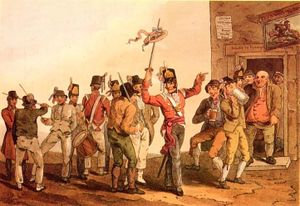
The Army did not have the same requirements as the Royal Navy – it was not a professional career in the same way. A young man joining the Army would buy a commission as Ensign (in a foot regiment; the cavalry equivalent was cornet) at anything from the age of fourteen upwards. This placed him automatically at a higher rank than a Navy midshipman, who did not hold a commission.
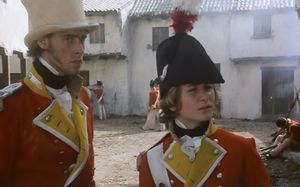
It is a misconception, though a common one, that officers had to have a university degree, or to be over a certain age. This has crept in thanks to modern requirements, but in 1811 it was possible for a boy of twelve or thirteen to hold a commission as an Ensign, if his father could pay for it. There were also certain regiments with boy drummers who would go on to serve in the ranks as private soldiers (the drummer boy is a staple of fiction set during this era, as is the boy officer). Overall, this meant that the average age of an officer in any rank is far lower than the age of an officer of the same (or equivalent) rank in the modern British Army.
Army officers learned 'on the job': There were no formal qualifications for holding a commission. An officer had to know how to read and write, and in the late 18th century and into the early years of the Regency, the majority of officers were from the upper classes, the gentry and aristocracy. By the end of the Peninsular War in 1814, this was no longer the case. Approximately 20% of officers were promoted from the ranks and more had gained their commissions by merit rather than purchase – several young men, unable to afford the purchase price, had been able to join as 'gentlemen volunteers', messing with the officers but doing the duties of a private soldier until a vacancy occurred that they could fill.
This was one of the few ways that a man with ambition could make the leap to becoming a gentleman, despite the risks.
Army Organisation
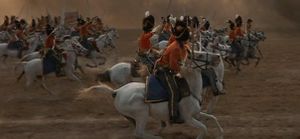
There were three main groupings within the British Army: Horse, Foot and Artillery (or, more properly, Cavalry, Infantry and Artillery)
The Cavalry
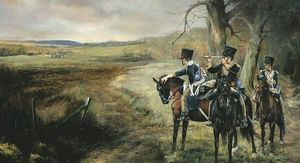
There were three main types of cavalry: Household, Heavy and Light.
The Household Cavalry were heavy cavalry. Their main task being that of guarding the Royal Household (hence the name) meant that they did not go on active service abroad until 1812. There were (and still are) two main Household Cavalry regiments, the Life Guards. The third Household Cavalry regiment, the Blues, was not confirmed as such until 1820.
The Heavy Cavalry comprised the Heavy Dragoons, who were the shock troops of the day.
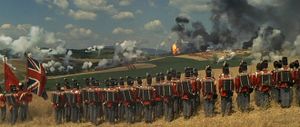
The Light Cavalry (either Light Dragoons or Hussars) were the scouting experts.
A cavalry regiment was made up of a number of squadrons, usually about six, each made up of two troops, and numbered about 900 men when at full strength. A squadron was commanded by a Captain, and each troop was under the command of a Lieutenant, with a Cornet to assist him.
(Note: There have been far fewer representations on-screen of the cavalry when compared with the infantry, and fewer still of Light Cavalry)
The Infantry
The British army of the time was structured around the regiment. Each Regiment had a number and in the Napoleonic Wars, the regiments were beginning to be associated with particular areas, such as the 33rd's association with the West Riding of Yorkshire. This area would be where they drew (or tried to draw) the majority of their recruits, and the regimental depot (headquarters and training camp) would be located.
Most regiments, but by no means all, had two battalions. The First Battalion, the more senior one, would be the one on campaign while the Second Battalion remained at home, acting as the recruiting and training centre for the Regiment.
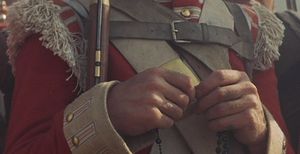
Within each battalion were ten Companies, each (when at full strength) with 100 men, including NCOs (non-commissioned officers). A Company was under the command of a Captain, and he had a Lieutenant and an Ensign under him. A battalion would have eight 'centre' or 'battalion' companies and two 'flank' companies. When in line, the Grenadier Company, made up of the tallest, strongest soldiers, stood on the right, and the Light Company, made up of the quickest and nimblest men, was on the left, with the Colours in the middle of the line.
The Colours were two big flags, made of silk, 6 feet by 6 feet 6 inches, on a nine-feet pole. One, the Regimental Colour, was the Regimental 'facing' colour and the other, the King's Colour was a Union flag. These two flags marked the presence of the Regiment. It was a great disgrace to lose the Colours and at the Battle of Albuera (on the 16th May 1811), the two Ensigns of the 3rd Foot ended up tearing the silk from the poles and wrapping it around them to protect them.
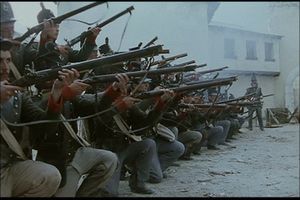
By the end of the Peninsular War, very few Regiments were at anything like full strength; there were regiments who stood in the line of battle with as few as 500 men. The Guards Regiments were almost the only exceptions to this, as they were the elite.
The Rifle Regiments did not carry Colours. They were also very different in their style of dress, their uniform being green and the officers' uniforms being based on those of the Light Dragoons.
Each regiment was dressed similarly, with the most noticeable differences being in the colour of the collars, cuffs and shoulder straps (collectively known as 'facings') of the men's jackets. They would be further differentiated by the pattern of the worsted tape, called lace, that they wore. Most infantry regiments (up to about a third of the Army) wore facings in various shades of yellow, and several regiments had green facings. There were some colours that were only worn by one regiment - such as the orange worn by the 35th Sussex Regiment, or the purple of the 56th West Essex.
Guards and Line Regiments
On the face of it, the Guards and Line look very similar, except that the Guards - the elite - generally took the tallest, smartest men they could. The Guards regiments were the 1st Foot Guards - after Waterloo also titled the Grenadier Guards; the 2nd Foot Guards or Coldstream Guards and the 3rd Foot Guard or Scots Guards. (The Welsh Guards were formed decades later). When at home in England, it was the Guards regiments who were tasked (as they are today) with guarding the royal residences, primarily Windsor Castle). Note: Although even in the Napoleonic era, the bearskin would be worn when in full dress (such as when on guard at Windsor Castle), when on campaign the soldiers wore the same black stovepipe shako worn by all other infantry soldiers.
The regular line regiments were numbered from the 1st Foot, or Royal Scots, all the way up to the 104th, raised for the War of 1812 between Britain and America. By the Napoleonic era, most regiments had a county designation or other title as well as a number - the 2nd Foot were the Queen's Regiment, the 3rd was the East Kent Regiment, nicknamed the Buffs or Old Buffs because of the buff - cream or off-white - colour of their facings. When referring to a Foot Guards regiment by its number, the designation 'Foot Guards' must always be used because the 1st Foot, 2nd Foot and 3rd Foot are regular line regiments and not Guards regiments - they are the Royal Scots, Queen's and East Kent regiments respectively.
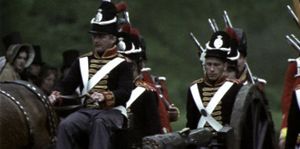
During the eighteenth century, once a war was over and peace was declared, regiments were disbanded. Usually the newest formed regiments (those with the highest regimental number) would be disbanded first. This was a direct response to the fear that a permanent standing army could rise and help its leaders take power - which was precisely what had happened in the 1640s with Cromwell and his New Model Army.
The Artillery
The Artillery came under the control of the Board of Ordnance, and its officers were drawn mainly from the middle class. They attended the academy at Woolwich to learn the science of their trade. Promotion was by seniority alone.
Rank Structure
The rank structure of the Army was simpler than that of the Navy. Broadly speaking, there were two classes: Officers and men (also referred to as 'rank and file' or, in modern parlance, 'Other Ranks' which covers the non-commissioned officers promoted from the ranks). The Other Ranks were:
Private (or equivalent, such as Guardsman or Fusilier) - Pte, in British Army shorthand
Lance Corporal - L/Cpl
Corporal - Cpl
Sergeant - Sgt
The ranks of Colour Sergeant and Sergeant Major did not come into existence before 1813, although the positions existed. A Colour Sergeant, before 1813, was merely a sergeant who was tasked with protecting the Colours. The Sergeant Major was what is now known as the Regimental Sergeant Major, and was the senior NCO of a regiment.
Officers' ranks were:
Ensign (or Cornet, in the cavalry. The Rifles' equivalent was 2nd Lieutenant.) - Ens
Lieutenant - Lt
Captain (usually in charge of a Company of 100 men) - Capt
Major (there were two Majors with a battalion) - Maj
Lieutenant Colonel (the executive officer in charge of a battalion of 1000 men, at full strength) - Lt-Col
Colonel (the officer in command of a full regiment) - Col
Brigadier - Brig
Major General - Maj Gen
Lieutenant General - Lt Gen
General Gen
Colonel was the highest rank available by purchase; anything higher was by seniority alone - when Wellesley was sent out to take charge of the Army in Portugal in 1808, a large number of officers senior to him were promoted in order that he could receive a promotion from Major General to Lieutenant General.
Purchasing a Commission
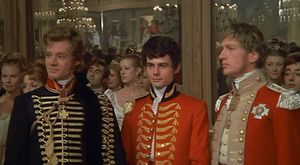
On joining the Army as an officer, a young man would purchase his initial commission (as Ensign) in a regiment. This was also referred to as 'buying ones Colours', the Colours being the two six feet square silk flags that marked a Regiment's position in battle. These flags were generally carried by the two junior ensigns of the Regiment, and protected by a group of senior NCOs, Colour Sergeants, who carried halberds or half-pikes.
The cost of an Ensigncy varied greatly depending on how fashionable the regiment he was joining was - a commission in the Guards cost a great deal more than the same rank in a line regiment such as the 50th Foot. Once he had served for a year or so, the Ensign could then purchase a promotion to Lieutenant by paying the difference between the value of the Ensigncy and the Lieutenancy, but he had to have served a minimum of a year as Ensign.
An officer could purchase a Captaincy in the same way, after a minimum of three years as Lieutenant. After a further two years, he could purchase his way up to Major, and thence to Lieutenant Colonel, then Colonel. Any promotions after that depended wholly upon his position in the Army List – the senior Colonels would be promoted to General as vacancies became available. Although the rank of Field Marshal existed, there was not a Field Marshall in the British Army at this time until 1814, when the Prince Regent promoted Wellington to that rank after the Battle of Vittoria.
Officers had to provide their own uniform (usually of scarlet superfine cloth - or blue superfine for light Cavalry officers) as well as their own camp equipment, tent etc. It was unusual for infantry officers below the rank of Captain to ride, but captains and above were more often mounted than not, especially on the march - and they had to provide their own horse and tack too. Cavalry officers also provided their own horses (usually of higher qualities than the men's troopers) and tack. It was very common for subalterns to club together to share the costs of a tent and pack-mule, whereas officers of the rank of Captain and above more often bought their own.
It was common to purchase a promotion into a different regiment where there was a vacancy, rather than waiting for a vacancy to occur in the regiment an officer was currently serving in. Such transactions would be handled by regimental agents, who knew and could deal with all the intricacies involved. It was also a frequent occurrence for one officer to arrange to exchange with another (usually poorer) officer of the same rank if his regiment was going to be posted abroad – for example, to the West Indies, which was an extremely unhealthy posting in the days before vaccinations against diseases such as yellow fever, which was very prevalent there, and usually lethal.
An officer did not have to purchase every promotion; after a major battle there were usually vacancies that meant surviving officers were promoted. An officer could also be gazetted to a more senior rank. This was basically a field promotion, but had to be ratified by Horse Guards (the Army equivalent of the Admiralty). It was also common for a man to hold a rank within the army as a whole that he did not hold within his regiment. This meant that a Captain could act with the authority of a Major (and would actually be addressed as Major) while on detached service away from his regiment, but would revert to Captain when back with his regiment.
Retiring
When an officer of the rank of Colonel or below wished to retire, he could 'sell out' which meant selling his commission for its full price, creating a vacancy so that more junior officers could move up the ranks. He might choose instead to transfer to the half-pay list. This was a list of retired or invalided officers who did not wish, or could not, serve in the field. They received half-pay, which was a sort of pension, paid every quarter or so. Gerald Stapleton is one such officer. The actual income was not actually half the pay they would receive as serving officers.
A Naval Lieutenant was the equivalent of an Army Captain.
A Naval Captain was the equivalent of an Army Lieutenant Colonel
Rates of Pay
| Cavalry | Infantry | |
|---|---|---|
| Colonel | 32s 10d | 22s 6d |
| Lt. Colonel | 23s | 23s |
| Major | 23s | 23s |
| Captain | 14s7d | 9s 5d |
| Lieutenant | 9s | 4s 8d |
| Cornet/Ensign | 8s | 3s 8d |
| Adjutant[1] | 5s | 4s |
| Paymaster | 15s | 15s |
| Paymaster Sergeant | 2s 11d | 1s 6 3/4d |
| Quartermaster | - | 4s 8d |
| Surgeon | 11s 4d | 9s 5d |
| Assistant Surgeon | 5s | 5s |
| Surgeon's mate | 3s 6d | 3s 6d |
| Veterinary Surgeon | 8s | - |
| Sergeant | 2s 11d | 1s 6 3/4d |
| Corporal | 2s 4 1/2d | 1s 2 1/4d |
| Trumpeter | 2s 4d | - |
| Drummer | - | 1s 1 3/4d |
| Fifer | - | 1s 1 3/4d |
| Private | 2s | 1s |
Characters with an Army connection
There are several characters, both current and former, in LL who have some sort of connection to the Army.
- Lieutenant-Colonel Robert Fitzgerald holds a commission in the 14th Light Dragoons and has recently returned from Spain to recuperate from an injury in London.
- Lt-Col Hugo Fotherington holds a commission in the 11th Light Dragoons. He was recently promoted to Lt-Col in-game, on the 22nd April 1811[2]
- Lord Gabriel Pritchard is a major in an unknown regiment of light dragoons.
- Major Gerald Stapleton is a half-pay officer of the Ninth Foot (Norfolk)
- Captain Thomas Sterne is an infantry officer in the 47th Foot, and has recently married Rebecca Garrison
- Major Felix Sutcliffe is an officer in the 2nd Foot Guards, recently transferred to the half-pay list because of injury.
Further Reading
Most of my sources are from books, but I do have various links for those who are interested
- The First Respectable Spy: The Life and Times of Colquhoun Grant, Wellington's Head of Intelligence, Jock Haswell, Hamish Hamilton, London, 1969
- Wellington's Spies, Mary McGrigor, Leo Cooper, London, 2005
- Redcoat Officer 1740-1815, Stuart Reid and Gerry Embleton, Osprey, Oxford, 2002
- Tactics and the Experience of Battle in the Age of Napoleon, Rory Muir, Yale University Press, New Haven, 1998
- All For the King's Shilling: The British Soldier under Wellington 1808-1814, Edward J. Coss, University of Oklahoma Press, 2010
- Galloping at Everything: The British Cavalry in the Peninsular War and at Waterloo 1808-15 - A Reappraisal, Ian Fletcher, Spellmount, Staplehurst, 1999
- Inside Wellington's Peninsular Army 1808-1814, Rory Muir, Robert Burnham, Howie Muir, Ron McGuigan, Pen & Sword Books, Barnsley, 2014
- Wellington's Army 1809-1814, Sir Charles Oman, Greenhill Books, London, 1913
- The Armies of Wellington, Philip Haythornthwaite, Brockhampton Press, London, 1996
- Life in Wellington's Army, Antony Brett-James, Tom Donovan Publishing, London, 1994
- Redcoat: The British Soldier in the Age of Horse and Musket, Richard Holmes, HarperCollins, 2001
- Peninsular Preparation: The Reform of the British Army 1795-1809, Richard Glover, Cambridge University Press, 1963
- A Commanding Presence: Wellington in the Peninsula 1808-1814, Ian Robertson, Spellmount, Stroud, 2008
- Britain Against Napoleon: The Organisation of Victory, Roger Knight, Penguin Books Ltd, London, 2013
- In These Times: Living in Britain Through Napoleon's Wars 1793-1815, Jenny Uglow, 2014
Notes
<references>
- ↑ Adjutant is not a rank but a position. As the colonel's personal staff officer, he is in charge of all the organisation, administration and discipline for the battalion or regiment in which he serves. Recruits have to 'pass the adjutant' before they are considered capable of performing all the drill required of them. This just means that they have to show the adjutant that they are capable of marching, saluting etc.
- ↑ http://www.thelondonliferpg.com/forums/index.php?/topic/598-military-despatches/